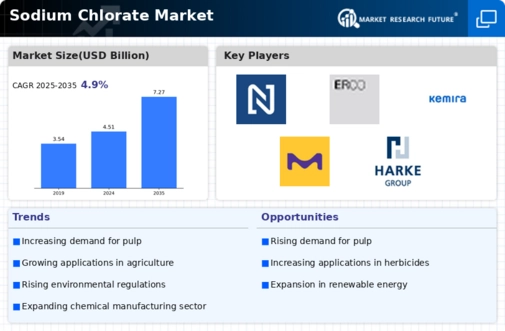Top Industry Leaders in the Sodium Chlorate Market
 Sodium chlorate, a seemingly unassuming molecule adorned with sodium, chlorine, and three oxygen atoms, wields surprising power in the industrial world. This versatile chemical serves as a key player in several critical processes, from bleaching paper pulp to manufacturing herbicides and rocket propellants. Consequently, the sodium chlorate market is a bustling arena, where established giants and agile startups battle for market share in a symphony of competition and innovation. To navigate this dynamic space, a keen understanding of the strategies at play, the factors influencing market share, and the recent developments shaping its trajectory is crucial.
Sodium chlorate, a seemingly unassuming molecule adorned with sodium, chlorine, and three oxygen atoms, wields surprising power in the industrial world. This versatile chemical serves as a key player in several critical processes, from bleaching paper pulp to manufacturing herbicides and rocket propellants. Consequently, the sodium chlorate market is a bustling arena, where established giants and agile startups battle for market share in a symphony of competition and innovation. To navigate this dynamic space, a keen understanding of the strategies at play, the factors influencing market share, and the recent developments shaping its trajectory is crucial.
Market Share: A Balancing Act of Demand and Supply
Several factors orchestrate the dance for market share in this salty sphere:
-
Pulp and Paper Industry: As the primary consumer of sodium chlorate for pulp bleaching, its fortunes are closely tied to the paper industry's health. Asia-Pacific, particularly China and India, drive demand due to booming paper production, while mature markets in North America and Europe witness stable growth. -
Herbicide Applications: Sodium chlorate is a key ingredient in several herbicides, finding use in weed control for agriculture, railways, and roads. Regulatory restrictions and growing awareness of eco-friendly alternatives, however, pose challenges. -
Technological Advancements: New production methods like oxygen-deprived electrolysis are reducing environmental impact and improving efficiency, making sodium chlorate more competitive. -
Supply Chain Volatility: Raw materials like brine and chlorine experience price fluctuations and supply disruptions, impacting production costs and profitability. Companies with secure supply chains and diversified product portfolios have a distinct advantage.
Strategies for Salty Supremacy: Mastering the Chemical Dance
Market leaders are wielding a potent arsenal of strategies to outmaneuver their rivals:
-
Vertical Integration: Securing control over the entire value chain, from brine extraction to chlorate production and distribution, reduces costs and ensures quality. Companies like Nouryon and CHG are actively integrating upstream and downstream. -
Product Diversification: Offering a diverse range of chlorate grades and specialty formulations caters to specific industry needs and opens doors to new markets. Hunan Hengguang Chemical and ERCO are leading the charge in product development. -
Geographical Expansion: Establishing a strong global presence is vital for capturing market share across diverse regions. Lianyungang Xingang Chemical and Chemtrade are expanding their international footprint. -
Sustainability Focus: Investing in cleaner production processes, like closed-loop recycling and renewable energy use, resonates with customers and regulators. Inner Mongolia Lantai Industrial and Sanxiang Electrochemical are actively implementing sustainable practices.
Key Companies in the sodium chlorate market
- Arkema SA (France)
- Nouryon (The Netherlands)
- ERCO (Canada)
- Kemira (Finland)
- Merck KGaA (Germany)
- China First Chemical Holdings Limited (China)
- HARKE GROUP (Germany)
- Tronox Holdings plc (US)
- Chemtrade (Canada)
- Brenntag AG (Germany)
- Ercros S.A (Spain)
Recent Developments:
-
September 2023: A consortium of Chinese chemical companies announces plans to build a large-scale plant dedicated to bio-based sodium chlorate production, aiming to disrupt the traditional chlorine-based process. -
October 2023: Nouryon partners with a leading paper manufacturer to develop next-generation bleaching processes using recycled sodium chlorate, promoting circular economy practices within the industry. -
November 2023: The US Environmental Protection Agency announces stricter handling and disposal guidelines for sodium chlorate, leading to increased safety measures and potential cost implications for producers. -
December 2023: A breakthrough in catalytic conversion processes allows for the direct production of sodium chlorate from salt, potentially unlocking a more efficient and resource-friendly production route.









